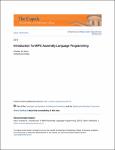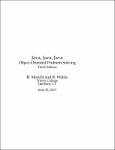Search
Author
- McFadyen, Ron (2)
- Kann, Charles (1)
- Morelli, Ralph (1)
- Walde, Ralph (1)
- next >
Subject
- BlueJ (2)
- programmer (2)
- C/C++ (1)
- Computer Science (1)
- next >
Date issued
- 2016 (4)
Has File(s)
- true (4)
Search Results
"This book was written to introduce students to assembly language programming in MIPS. As with all assemblylanguage programming texts, it covers basic operators and instructions, subprogram calling, loading andstoring memory, program control, and the conversion of the assembly language program into machine code.
However this book was not written simply as a book on assembly language programming. The larger purposeof this text is to show how concepts in Higher Level Languages (HLL), such as Java or C/C++, arerepresented in assembly. By showing how program constructs from these HLL map into assembly, theconcepts will be easier to understand and use when the programmer implements programs in languages likeJava or C/C++. Concepts such as references and variables, registers, binary an... |
This book is Part II of a two-part set that introduces the Java programming language. The text assumes the student will be using the BlueJ development environment and provides some introductory BlueJ material. Our experience has been that BlueJ is easy to learn and provides a good programming environment for the beginner programmer. |
This book is Part I of a two-part set that introduces the Java programming language. The text assumes the student will be using the BlueJ development environment and provides some introductory BlueJ material. Our experience has been that BlueJ is easy to learn and provides a good programming environment for the beginner programmer. |
"We have designed this third edition of Java, Java, Java to be suitable for a typical Introduction to Computer Science (CS1) course or for a slightly more advanced Java as a Second Language course. This edition retains the “objects first” approach to programming and problem solving that was characteristic of the first two editions. Throughout the text we emphasize careful coverage of Java language features, introductory programming concepts, and object-oriented design principles.
The third edition retains many of the features of the first two editions, including:
Early Introduction of Objects
Emphasis on Object Oriented Design (OOD)
Unified Modeling Language (UML) Diagrams
Self-study Exercises with Answers
Programming, Debugging, and Design Tips.
From the Java Library Sec... |




